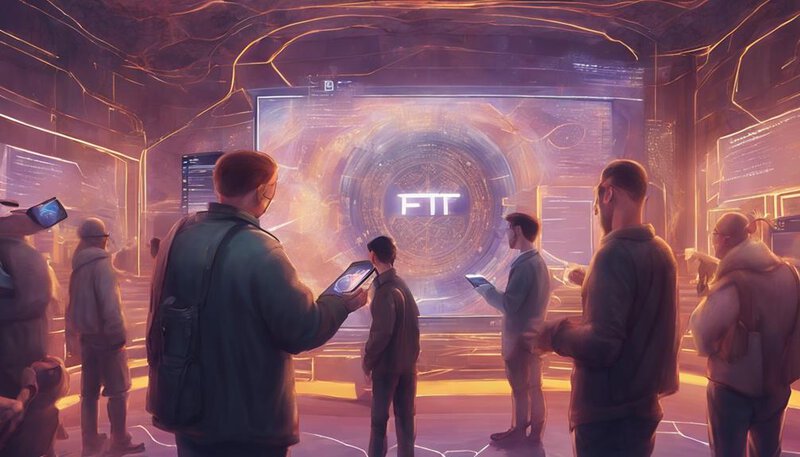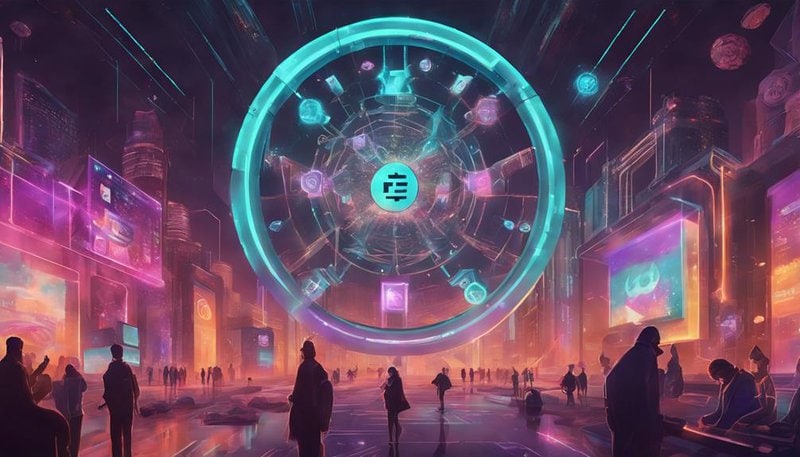Why NFTs and DeFi Intersect: Opportunities and Challenges

Exploring the world of NFTs and DeFi can offer exciting opportunities for investors and creators alike. Non-fungible tokens (NFTs) have gained popularity for their ability to represent ownership of unique digital assets, such as art, music, and virtual real estate. This has opened up new avenues for artists to monetize their work and for collectors to invest in digital collectibles.
On the other hand, decentralized finance (DeFi) has revolutionized traditional financial services by leveraging blockchain technology to create a more open and inclusive financial system. DeFi platforms enable users to borrow, lend, and trade assets without relying on intermediaries like banks. This has the potential to provide financial services to underserved communities and reduce barriers to entry for individuals looking to participate in the global economy.
However, the rapid growth of NFTs and DeFi also poses challenges, such as regulatory uncertainties, security risks, and scalability issues. As these technologies continue to evolve, it will be essential for investors, creators, and regulators to work together to address these challenges and unlock the full potential of NFTs and DeFi for the benefit of all stakeholders.
The Rise of NFTs and DeFi
In the dynamic landscape of digital assets, the convergence of NFTs and DeFi has sparked a profound transformation in the realm of decentralized finance. The rise of NFT adoption and DeFi integration has brought about a new era of possibilities and challenges. NFTs, with their unique digital ownership capabilities, have opened doors for creative expression and asset tokenization. Simultaneously, DeFi has revolutionized traditional financial systems by offering transparent, permissionless, and efficient ways to manage assets and generate returns.
The integration of NFTs into DeFi platforms has unlocked innovative opportunities for users to leverage their digital assets in ways previously unimaginable. By combining the scarcity and provenance of NFTs with the liquidity and composability of DeFi protocols, individuals can now participate in decentralized lending, borrowing, and trading using their tokenized assets as collateral.
As NFT adoption continues to grow and DeFi integration deepens, the intersection of these two technologies will undoubtedly shape the future of finance, empowering individuals to take control of their wealth and engage in a more inclusive and decentralized financial ecosystem.
Shared Principles and Innovations
As you explore the shared principles and innovations at the intersection of NFTs and DeFi, consider the common ground that unites these two realms.
The potential for collaboration between DeFi and NFTs opens up exciting possibilities for new financial instruments and decentralized applications.
Embracing these synergies can lead to groundbreaking advancements in both sectors, pushing the boundaries of what's possible in the digital economy.
Common Ground in DeFi
Navigating the landscape of decentralized finance reveals a tapestry woven with shared principles and innovative solutions. In the realm of DeFi, there are key commonalities that form the foundation of this revolutionary ecosystem:
- Decentralization: DeFi platforms prioritize autonomy and eliminate the need for intermediaries.
- Transparency: Transparent smart contracts ensure that all transactions are visible to participants.
- Accessibility: DeFi strives to provide financial services to anyone with an internet connection, promoting inclusivity.
- Security: Innovations like decentralized exchanges and secure lending protocols aim to protect users' funds.
These shared principles underline the essence of DeFi integration and hint at the vast potential for NFT applications within this transformative space.
DeFi-NFT Collaboration Potential
Explore the boundless potential of collaboration between DeFi and NFTs, where shared principles and innovative solutions converge to redefine the financial landscape.
The synergies between Decentralized Finance (DeFi) and Non-Fungible Tokens (NFTs) present remarkable growth opportunities that can revolutionize the way we perceive and interact with assets.
By combining the transparency and security of DeFi with the uniqueness and ownership verification of NFTs, a new realm of possibilities emerges. Smart contracts can automate royalty payments for NFT creators, while decentralized marketplaces can enhance liquidity for NFTs.
This collaboration not only fosters creativity and inclusivity but also opens avenues for new financial instruments and services.
Embrace the potential of DeFi-NFT collaboration, where innovation thrives and boundaries blur in the pursuit of a more interconnected and efficient financial ecosystem.
Liquidity Pools and NFT Collateral

In the realm of decentralized finance and non-fungible tokens, the integration of liquidity pools with NFT collateral presents a unique landscape of opportunity and complexity. When considering liquidity pools and NFT collateral, it's vital to understand the following:
- Enhanced Liquidity: Utilizing NFTs as collateral can bring a new dimension to liquidity pools, offering increased flexibility and diversity in asset backing.
- Risk Management: Assessing the risk associated with NFT collateral is crucial for maintaining the stability and security of the liquidity pool.
- Market Volatility: The fluctuating nature of NFT values can impact the overall liquidity pool dynamics, requiring constant monitoring and adjustment.
- Innovative Yield Opportunities: By incorporating NFT collateral, new avenues for generating yield and attracting liquidity providers can be explored.
Understanding the intricate relationship between liquidity pools and collateralized assets in the NFT space is essential for navigating the evolving landscape of decentralized finance. By embracing these dynamics, you can harness the potential benefits while mitigating the associated risks.
Cross-Platform Integration Strategies
Embracing strategic cross-platform integration can unlock new synergies and efficiencies within the intersection of NFTs and DeFi. Achieving platform compatibility is essential for seamless interaction between NFT marketplaces and DeFi protocols. By bridging these ecosystems effectively, users can experience a more streamlined and interconnected environment. To ensure smooth operations, interoperability solutions play a pivotal role in enhancing the user experience and expanding the possibilities for decentralized finance.
Implementing cross-platform integration strategies requires a deep understanding of the unique characteristics of both NFTs and DeFi. By aligning these elements harmoniously, you can create a cohesive environment that maximizes benefits for users across different platforms. This approach fosters a more inclusive and accessible landscape for individuals looking to engage with both NFTs and DeFi seamlessly.
As you navigate the complexities of cross-platform integration, remember that adaptability and innovation are key. Embrace technological advancements that facilitate interoperability solutions, as they hold the potential to revolutionize the way NFTs and DeFi intersect, offering a more integrated and holistic experience for users.
Smart Contracts and Tokenization

To navigate the intricate realm where NFTs and DeFi converge, the utilization of smart contracts and tokenization emerges as a foundational element essential for facilitating seamless transactions and interactions. Smart contracts, powered by blockchain technology, are self-executing contracts with the terms of the agreement directly written into code. Tokenization involves converting real-world or digital assets into tokens, enabling fractional ownership and increased liquidity. Together, these elements revolutionize the way assets are managed and exchanged within the digital landscape, offering unparalleled security, transparency, and efficiency.
- Smart Contracts: Automate transactions and enforce agreements without the need for intermediaries.
- Tokenization: Enhances asset liquidity by dividing ownership into tradable tokens.
- Efficiency: Streamlines processes, reducing time and costs associated with traditional transactions.
- Transparency: Provides a clear and auditable record of transactions, enhancing trust among participants.
In embracing smart contracts and tokenization, individuals unlock a world of possibilities where decentralized finance and non-fungible tokens intersect, reshaping the future of digital transactions.
Regulatory Concerns and Compliance
Navigating the intersection of NFTs and DeFi brings to light a crucial consideration: the landscape of regulatory concerns and compliance. In the realm of blockchain technology, staying abreast of compliance challenges and regulatory hurdles is essential to ensure the sustainability and legitimacy of NFTs and DeFi platforms. As you delve into this dynamic space, it becomes apparent that regulatory clarity is a cornerstone for fostering trust and adoption.
Compliance challenges in the NFT and DeFi sphere stem from the decentralized nature of these platforms, often posing unique obstacles for traditional regulatory frameworks. As you navigate this landscape, understanding the evolving regulatory landscape and proactively addressing compliance issues is paramount. Embracing transparency and engaging with regulators can help mitigate regulatory risks and pave the way for sustainable growth.
Market Volatility and Risk Management

Embrace the ebb and flow of market volatility within the DeFi space, for it presents both risks and opportunities.
By employing effective risk mitigation strategies, you can navigate the unpredictable nature of these markets with confidence.
Safeguard your assets through proactive measures that prioritize security and stability in the face of fluctuating conditions.
Volatility Impact on Defi
Volatility Impact on DeFi
Amidst the dynamic landscape of DeFi, the impact of market volatility on risk management remains a crucial consideration for investors and participants. Understanding the implications of volatility is key to navigating the DeFi space effectively.
Here are some insights to help you grasp the volatility impact on DeFi:
- Increased Risk Exposure: Market volatility can amplify risks within DeFi protocols.
- Asset Price Fluctuations: Rapid price changes can affect the value of assets held in DeFi platforms.
- Liquidity Challenges: Volatility may lead to liquidity shortages or surpluses, impacting DeFi operations.
- Risk Assessment Complexity: Evaluating risks becomes more intricate in volatile market conditions.
Navigating these challenges requires a proactive approach to risk assessment and management in the realm of decentralized finance.
Risk Mitigation Strategies
As you ponder the implications of market volatility on DeFi, consider the significance of implementing effective risk mitigation strategies to safeguard your investments and navigate the complexities of decentralized finance. Risk assessment is a crucial initial step in understanding and managing potential threats.
Diversification techniques offer a shield against unforeseen market fluctuations by spreading your investments across different assets. By diversifying, you can reduce the impact of a single asset's poor performance on your overall portfolio. Moreover, staying informed about market trends and setting clear risk management protocols can help you respond swiftly to changing conditions.
Asset Protection Measures
Implementing robust asset protection measures is paramount when navigating the intricacies of market volatility and risk management in the realm of DeFi. To safeguard your assets effectively, consider the following:
- Data Encryption: Utilize advanced encryption techniques to secure your sensitive information from unauthorized access.
- Secure Storage: Store your assets in secure wallets or platforms that offer enhanced security features to protect against potential breaches.
- Diversification: Spread your investments across different assets to mitigate the impact of market fluctuations on a single asset.
- Continuous Monitoring: Stay vigilant and regularly monitor your assets to detect any anomalies or suspicious activities promptly.
Future Trends and Adaptation

To navigate the evolving landscape of NFTs and DeFi, one must anticipate future trends and be prepared to adapt swiftly. Embracing future adoption and staying attuned to technological advancements will be crucial in harnessing the full potential of this intersection. As the digital realm continues to expand and innovate, staying ahead of the curve will enable you to seize new opportunities and navigate challenges with grace.
Future trends suggest a shift towards increased integration between NFTs and DeFi, enabling seamless transactions and enhanced liquidity. Embracing this synergy will open doors to a plethora of possibilities, from fractionalized ownership to enhanced security measures. By remaining vigilant and adaptable, you can position yourself as a pioneer in this dynamic landscape.
Adaptation is key in this ever-evolving space, where staying stagnant isn't an option. By fostering a mindset of continuous learning and flexibility, you can ride the wave of innovation and emerge as a leader in the realm of NFTs and DeFi. Stay curious, stay agile, and embrace the future with open arms.
Frequently Asked Questions
How Do NFTs and Defi Intersect in Terms of Governance and Decision-Making Processes?
In the realm of NFTs and DeFi, governance structures intertwine to shape decision-making processes. Embrace this fusion, where decentralized communities wield power through voting mechanisms, shaping the future of digital assets.
Are There Any Notable Examples of Successful Projects That Have Effectively Utilized Both NFTs and Defi?
In the realm of blockchain, successful projects that blend NFTs and DeFi showcase innovative strategies. From decentralized marketplaces like Rarible to lending protocols such as Aave, these pioneers demonstrate the power of synergy in digital finance.
What Are the Potential Challenges of Integrating NFTs as Collateral in Defi Liquidity Pools?
When integrating NFTs as collateral in DeFi liquidity pools, potential risks emerge. Market volatility, smart contract vulnerabilities, and regulatory concerns must be carefully navigated. Ensuring transparency, security, and compliance is crucial for sustainable growth.
How Do Smart Contracts Play a Role in Facilitating the Interaction Between NFTs and Defi Platforms?
Smart contracts are the backbone of interoperability between NFTs and DeFi platforms. They enable seamless transactions, automated processes, and secure interactions. Embrace these technological marvels to unlock the potential of decentralized finance and digital assets.
What Are Some Potential Future Developments in the Intersection of NFTs and Defi That Could Impact the Market?
As you gaze into the horizon of the NFT and DeFi landscape, envision future trends shaping the market. Embrace the potential impact of innovative collaborations, evolving technologies, and shifting consumer behaviors on this dynamic intersection.









